Abstract
The urban culture and its transformations under the conditions when the urban environment transforms into a complex socio-biotechnical system are considered in this paper. The urban culture functions as open system, the changes of which are metabolic by nature. That means they are carried out in four successive stages: accumulation of “substances”, their protection during the decomposition of “substances” into simple and simultaneous development and consumption of complex “substances”; discharge of waste into the environment; and their subsequent transformation. Based on the generalization and interpretation of the data of the sociological study “Sociocultural Consequences of the Formation of Urban Socio-Biotechnical Systems”, carried out by the authors in the cities of the Belgorod region in January 2020, the specific features on how the urban youth react to peculiarities of the current stage typical to culture transformation are determined: a) the need to increase the level of autonomy of personality of young people and their self-sufficiency; b) evaluation regarding some cultural processes in the context of prospects connected with the personal development and interpersonal and inter-group communication; c) the differentiated approach to the transforming urban culture, due to the subcultural diversity that the modern youth have; d) awareness of some cultural values, mainly through the Internet and social networks; e) a selective approach to "culture + technologies", expressed in identification its positive and negative consequences; f) the contradiction between the relevance towards the environmental issues and poor understanding of its socio-cultural component.
Keywords: Ecologytechnology and cultureurban environmenturban cultureyouthyouth subjectivity
Introduction
A modern city, particularly metropolis, influenced by the global socio-economic and political processes and due to the logic of its own development, is transforming into a complex socio-biological system (Yanitsky, 2019), the integrity of which is provided with anthropogenic attractor – purposed human activity. During this process, all areas of the urban life undergo some transformations, despite the fact that in some of them the changes are slow, which are not always recorded by a layman and researchers. Culture is reasobably included to these spheres. Low, in comparison with many other areas of life, the sociodynamics of some cultural processes is determined by the fact that:
they are based on value-semantic complexes, which, under the conditions of the society evolutionary development, which takes place gradually and over the time;
culture is largely closed to traditions, and with all the outward diversity of creative innovations, it retains the traditional core, which is transmitted from generation to generation.
However, the high inertia of the cultural core does not lead to the urban culture protection, it functions as open system, the changes of which are metabolic (Babintsev et al., 2019), that is, they are carried out in four successive stages: the accumulation of “substances”, their transformation during decomposition of "substances" into simple and simultaneous formation and consumption of complex "substances"; discharge of waste into the environment; and their subsequent transformation (Ermolaeva et al., 2019; Kennedy et al., 2007; Tarr, 2002; Warren-Rhodes & Koenig, 2001).
The changes in the field of the urban culture, on the one hand, are the result of deliberate or spontaneous activities of humans (cultural practices); on the other hand, they are setting new conditions stimulating the cultural creativity. Naturally, the consequences of the transformation happening in the cultural sphere show up in different ways the life concept and how it is taken mass by the specific social groups. Of particular interest is the analysis on the reaction of the urban youth to these transformations, and it is (the interest) due to a number of circumstances:
firstly, the youth is a socio-demographic group in a situation of appropriation and assimilation of subjectivity, that means the ability to make independent decisions that reflect the identity and carry out autonomous actions, influencing the behavior of others. As noted by Smirnova, the essential signs of the social subjectivity of young people are: willingness and ability to manage their actions, to model the ways of interaction, to implement the programs as planned, to monitor the course and adequately evaluate the results of their actions; to reflect on their activities and the activities of others (Smirnova, 2017). Moreover, the process of mastering subjectivity implicitly implies the need to have the identity. But the identity is always associated with the internalization of the value system, which is the standard for a particular social community. Considering the problem of the Russian identity, Onosov, Gasparishvili and Shafranets write: “To understand the ethnic identity of the Russians, it is important to represent the system of values adopted in the Russian ethnic group and structuring its public consciousness” (Onosov et al., 2018, p. 501), in the subjectivity development of the youth, a pronounced cultural aspect is traced;
secondly, the youth is inherently transgressive and marginal (Kirdiashkin, 2008), and because of this, it is usually more acute than representatives of older generations to respond to changes in social and cultural reality, often with newfangled trends, affirming them as normative cultural practices in future;
thirdly, the significant subcultural diversity of the youth (Koltunov, 2011) often manifests itself in a position clash regarding the perception and appreciation of some cultural phenomena. This often leads to the conflicts, which, externally manifesting themselves as the opposite of tastes, aesthetic and other preferences, have prerequisites associated with the existential foundations of the youth life and lead to destructive consequences for the entire urban community, increasing the social disjunction and stimulating the emergence of destructive consequences risks.
The paper materials prove the idea that the youth position in the field of the urban culture acquires significance not only in terms of understanding the development prospects for the youth themselves, but also of reproducing the urban community as a whole. However, a necessary condition for such an analysis is the diagnosis of the youth dispositions regarding the phenomenon of the modern urban culture and its developmental trends.
Problem Statement
The research problem is determined by the contradiction between the need to understand the position of young people in transforming urban culture and the lack of empirical evidence to identify the specifics of young people's attitudes to the main trends of its development.
Research Questions
The subject of the article is the dispositions of young people regarding the processes taking place in the modern urban culture.
Purpose of the Study
The aim of the article is to develop a firm conception based on the results of some empirical research regarding the features characterizing the processes replication taking place in the modern urban culture in the youth mentality.
Research Methods
The article is based on the results of the sociological study “Sociocultural Consequences of the Formation of Urban Socio-Biotechnical Systems” conducted in the cities of the Belgorod Region in January 2020. The study included the questionnaire survey of the urban population using the quota sampling technique (n = 500), the expert survey (n = 30), the focus group with young people based on a pre-compiled scenario (guided instructions). In the course of the study, the urban citizens aged 14–29 years were assigned as the youth.
The research objectives included:
to determine the culture value for the youth as a factor in their personality development;
to analyse the attitude of the youth to the phenomenon of the culture;
to identify the main sources of informing the youth about the cultural life of a city;
to identify the motivation for cultural preferences among the youth and the structure of their cultural needs;
to assess the youth's perception of technologization and ecodesign of the cultural sphere.
Findings
Culture value for youth as a factor of personality development
The research showed that young people appreciate highly the culture role in their life. Only 41 % of the respondents in this group believe: it is very important for human well-being in a modern city; 12 % define this value as "low"; only 4 % are convinced that the culture does not matter anything in the context under consideration. At the same time, 42 % of young people believe that the importance of the culture on human well-being depends on a person itself. 1 % of the respondents hesitated in giving a respond (figure
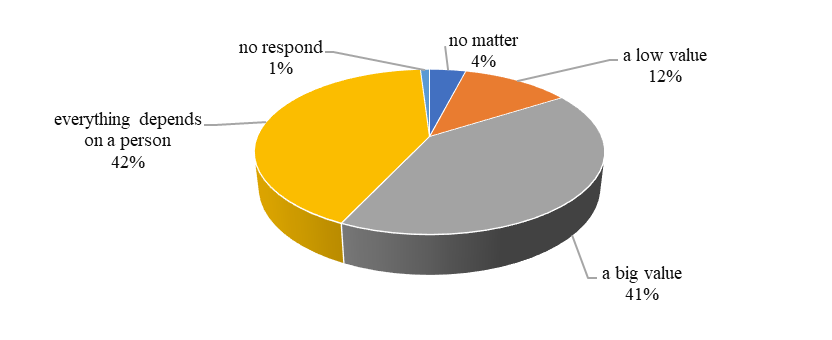
The young people position in this case does not stand out in the total number of opinions. In general, the responses were distributed as follows: importance – 44 %; a low value – 16 %; does not matter – 5 %. However, among all the respondents, only 30 % associated the importance of the culture and personal well-being with the characteristics of a person itself. We consider it possible to connect the revealed difference with the fact that for young people, in comparison with older generations, a more differentiated view on their environment is more characteristic. They more often consider gaining prosperity and success in life as a whole with the efforts of a particular individual and are much less likely to explain the consequences of the universal trends. A person in the context of their worldview is much more autonomous and self-sufficient than it is usually believed in the Russian tradition. So, Mikhailova and Cherkasov (2015) on the basis of a number of sociological surveys conducted during 1992-2015 note that “young people focus on the strong-willed qualities of the individual, allowing them to adapt in the best way in the competitive environment of the marketable society (p. 65).
The culture value for a modern urban citizen can be explained by the fact that 54 % of young people consider the ability of the culture to ensure the personality development; 42 % of the respondents attributed the importance of the culture with the potential to build up relationships with others; whereas, 33 % – with its function of constituting the system of social rules; 28 % see the importance of the culture in its ability to provide the continuity to traditions; 26 % think that it is able to shape the norms helping to develop some right attitudes to environment. It is noteworthy that only 16 % are convinced that the culture contributes to a career, as much as it gives the opportunity to develop a healthy personality and a positive image (figure
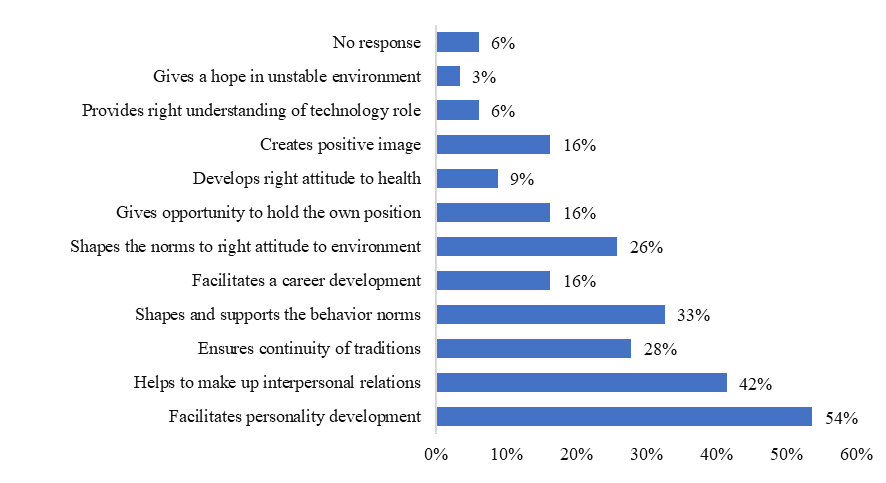
Consequently, for young people, the main value of the culture is not associated with a utilitarian and practical nature (career, image), but with the prospects of the personal development and, which is especially important, the development of interpersonal and inter-group communication. It seems very remarkable the desire of the young urban residents to highlight in the culture exactly the aspect of interaction and communication. It is no coincidence that the main characteristics by which young people identify a cultured person, the respondents called some good manners (63 %); correct speech/language (52 %); sociability (45 %). At the same time, intellectual abilities and knowledge as indicators of a cultured person are only in the third place (44 %), and honesty and decency account for only 35 %.
The emphasis on the communicative component of the culture was voiced while conducting the focus group. Some examples of it: "This is not something about going to museums and look at paintings. This is how a person manifests himself in relationships with other people in some difficult situations. This is more about a human behavior in the society” (young man, 18 years old).
The intention (probably largely unconscious) to reduce the culture to the level of communicative competencies most likely reflects the feeling the deficiency of “healthy” interpersonal communication in a modern city, connected with a sort of social isolation about which Baudrillard wrote once (Baudrillard, 2001).
Attitude of the youth to the phenomenon of the culture
Young people in the modern urban culture are most often attracted by: accessibility (37 %); the diversity of its forms (33 %); focused on the interests of an “ordinary” person (28 %); attention to the environmental issues (25 %); democracy (21 %). To a slightly lesser degree – patriotic orientation (18 %); use of some technical equipment (17 %); connection with the national traditions (16 %) (figure
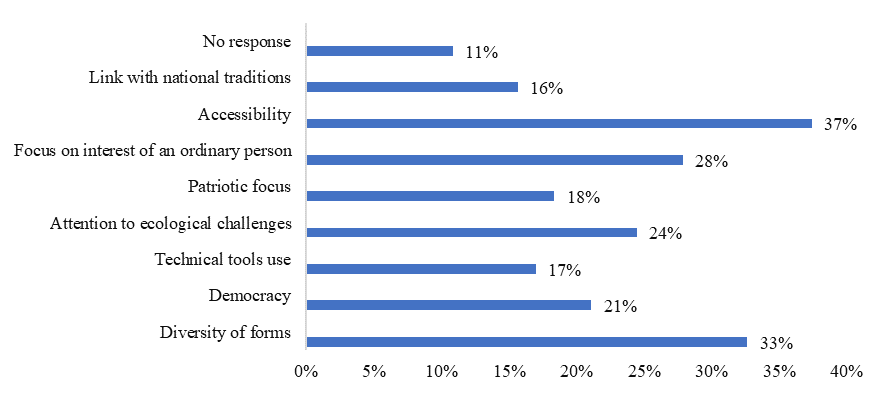
The respondents do not like mostly: commercialization (30 %), dominance of “pops” (27 %), groupism, and clannishness (24 %), inappropriate language (24 %), low aesthetic level (22 %), and violence propaganda (20 %). Much less rejection of the respondents is caused by an elitist character (16 %) and isolation from the national traditions (9 %) (figure
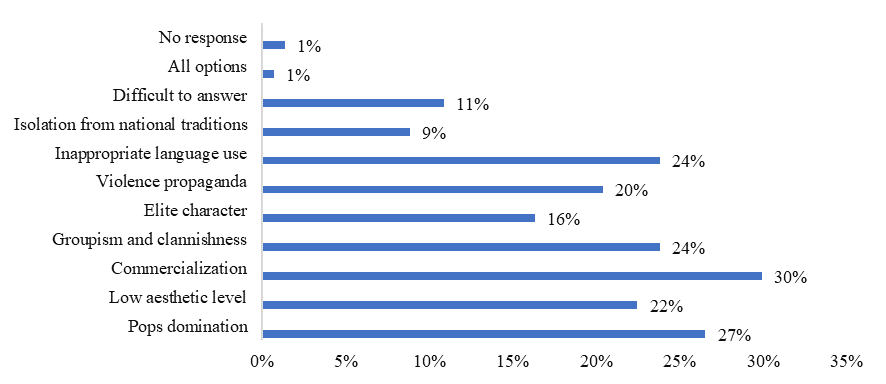
The distribution of the responses generally corresponds to the picture obtained during the survey among the urban citizens. Deviations do not exceed the statistical margin of error. The only exception is the position of “accessibility of the culture”. In the total mass of the respondents, it attracts only 31 % of them. This is most likely due to the fact that the representatives of the older generations have much less opportunities than young people to use the channels through which today they most often possess the cultural values.
The main information sources for young people about cultural life of a city
The questionnaire confirmed that these sources are the Internet and social networks. They serve as sources able to give some information about the cultural life for 58 and 40 % of young people, respectively. In the total number of the respondents, these indicators are 50 and 27 %. The Internet and virtual networks were pointed out as necessary things in meeting cultural needs by the focus group interview. The focus-group participants, in particular, agreed with the following opinion: “Information about some cultural events is now being heard not so much through the official channels, but through some media personalities, e.g., bloggers who have a large audience. Young people do not subscribe to some official websites of the urban authorities in various social networks, as it is not interesting to them. Media people can present this correctly and gather a large audience” (young man, 20 years old). However, it should be noted that some of the respondents also pointed out some drawbacks of it. The following opinion was quite typical: “The main disadvantage is that we are moving into the virtual world, and life communicatio is getting less and less. What we want to say can be expressed in the comments on social networks. In the real life, people are becoming more closed and there are less friendly relations between people” (girl, 18 years old).
The older generations are more focused on television (64 % among those who are 60 years old or more). But it is obviously, either the modern Russian television cannot offer some cultural programs satisfying the urban citizens, or they themselves choose to regularly watch other programs.
For 36 % of young people, television continues to be the main source of information about the cultural life; for 34 % the information source is friends and colleagues. All other sources have significantly less influence on the cultural practices development among the younger generation. Only 21 % of the respondents receive the information from books, 13 % – from newspapers and magazines. And, most notably that only 10 % of the respondents receive the information from the employees who work in cultural institutions. The fact questions the effectiveness of the municipal cultural policies in cities, and not only regarding the youth, since in the total number of the respondents this indicator is only 12 %.
Motivation for cultural preferences among young people and their cultural needs
The main criterion among young people in identifying the culture priorities is their compliance to the moral standards. And although less than half of the respondents (41 %) are guided by this criterion, it is significantly ahead of all other criteria in terms of choosing the number of options. 34 % of the survey participants are guided when making a choice with the resource availability; 30 % – with the compliance to aesthetic standards; 27 % – with entertainment point; 23 % – novelty, and even provocation; 21 % – with focus on a tradition. All other criteria in making a choice have less importance to the youth. So, 14 % of the young people pay attention to the conformity of the cultural preferences with fashion and recommendations of some authoritative people; for the official approval – 6 % (figure
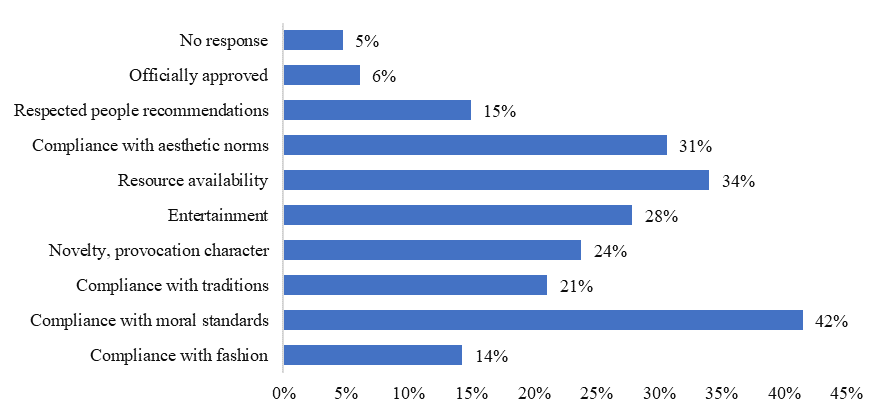
The distribution of the responses in this case revealed that the dispositions of the respondents belonging to the youth cohort almost do not differ from the positions of the urban citizens as a whole. Some significant discrepancies can be traced only in relation to the criterion of "compliance with tradition". Most part of the population (29 %) are guided by it. This, in our opinion, is understandable, since the representatives of the older generations are much more aware of the cultural traditions than young people and, as a rule; they are more conservative in their views.
Young people are more autonomous and independent, not only in relation to traditions. The relative majority of its representatives (36 %) in identifying their cultural preferences is focused on their own choice/opinion. Only 27 % consult with friends and relatives; 24 % rely on reviews in mass media. Even the opinion of the social networks participants in this case is important only for 23 % of the respondents. And only 19 % pay attention to the recommendations of experts.
The structure of the cultural needs of the youth is diverse. Despite all the transformations, reading literature is a priority among them (36 %). Further, in decreasing the frequency of choice there are: visiting concerts (32 %), chatting on social networks (29 %), visiting museums, galleries, exhibitions (26 %), watching TV shows (24 %), visiting concerts (22 %), visiting sporting events (21 %), going to the theater (15 %) (No more than three possible answers were allowed.) . This diversity undoubtedly reflects a significant subcultural differentiation of the urban youth environment.
Youth's perception of technologization and ecodesign of cultural sphere
Young people are very reserved in their response to using technologies in developing the modern urban culture. The technology impact 40 % of the experts rated as the most typical feature of the culture transformation. Only 42 % of the young people believe that the widespread use of information technology and gadgets has made the urban culture more popular (though in the total number of the respondents this figure is even lower – 36 %), which is most likely to be considered as evidence of the lack of excessive technological optimism in the youth environment and the technological cretinism as a consequence of it. The latter comes down to the attempt to prove that information and computer technologies and, especially, digitalization can solve, if not all, then a great number of social challenges.
However, it should be noted that the issue relating the culture demand in the context of its technologicalization is quite complex. During the focus group, the participants repeatedly emphasized – in this case, much again depends on the personality of a young man. Most interviewees agreed with the following statement: "Regarding the demand – there are different types of the culture. Everyone will have the own culture. For young people, the culture of communication and various fashion trends are most in demand, museums are probably the least popular. There is not enough free time to take a break from study and work” (girl, 22 years old).
The main positive consequences of the urban culture technologization (noted by 55 % of the respondents) are seen by young people as cultural values because they are becoming more accessible (43 %), new types of art based on information technologies appear (31 %), there is an opportunity to directly discuss and evaluate the effects gained from the cultural activities (27 %). Only 12 % of the respondents are convinced in the quality rise in the sphere of the culture and art due to technologization.
Among the main negative consequences (46 % of the respondents admitted them), the young citizens included: an increase in low-quality and inaccurate information, cultural “garbage” (38 %), the spread of “piracy” that infringed copyrights (20 %), the degradation of some traditional ways to create and consume the cultural property (19 %), the transformation of the culture into a product to sell (16 %).
Ambiguous replication in the youth consciousness is received by excodesign of the urban culture. On the one hand, the modern studies of the environmental culture challenges show that despite the firm position of the selfish consuming paradigm that exists in the mass mentality, new socio-environmental ideas gradually “fit” into the minds of young people and begin to function in society (Ivleva et al., 2019). So, according to the author’s poll, 42 % of the respondents are concerned about the environmental situation in their city, which is quite logical, especially considering the general negative environmental trends. On the other hand, only 20 % of the respondents consider the environmental protection as a necessary quality for a cultured person. During the focus group interview, this duality was reflected, in particular, in the fact that the participants, recognizing the need to possess the modern environmental technologies oriented to nature protection, extremely carefully associated these skills with the cultural characteristics of an individual. Typical one was, for example, a statement supported by several participants at once: "Most likely, this is one of the factors of the human culture. But it cannot be said that if a person masters the environmental technologies, then he/she is definitely cultural” (girl, 24 years old).
Conclusion
Based on the study, it is possible to draw the following conclusions.
The social processes that characterize both the development of the modern city and the urban culture, including the youth themselves, do not unambiguously lead to the alienation of most young people from the cultural values. But the specifics in the attitude existing among young residents to the cultural phenomena is increasingly determined by the ideas related to the need to increase the level of personality autonomy of a young man and his self-sufficiency. The importance of the culture is increasingly viewed by young people in the context of proper subjectivity development.
For young people, the communicative quality of the urban culture, its ability to establish communication both among the young people themselves and with external counterparties is becoming increasingly important, which indirectly indicates an increase in the attitude towards achieving a public conjunction in the urban community.
The subcultural diversity of the youth, represented by many spiritual worlds, determines a differentiated approach to the transforming urban culture. Young people increasingly attribute its positive qualities to the variety of forms and accessibility. Rejection is caused mainly by commercialization and low aesthetic content, the concept of "pop" is becoming its concentrated reflection.
The main translators of the cultural values for the urban youth are the Internet and social networks.
Despite all the socio-cultural changes, for most of the urban youth, when assessing the cultural phenomena, ethical and aesthetic criteria keep their importance. However, along with them, when determining the cultural preferences, the significant part of young people comes from purely pragmatic considerations – resource availability and novelty.
Young people are not characterized by unconditional optimism regarding the technological processes happening in the urban culture. Young residents of the city see both positive consequences of this process (increasing the accessibility of the culture, its democratization), and side-effects, the main of which is the increase of “cultural garbage”. However, the understanding of its content is characterized by excessive simplification – the respondents usually associate “garbage” in the culture with poor-quality and unreliable information.
The vast majority of the young urban citizens are characterized by a contradiction between the awareness of the relevance of environmental issues and the insufficient understanding of its socio-cultural component.
Acknowledgments
The article was prepared with the financial support of the RFBR in the framework of the scientific project “Socio-cultural consequences of the formation of urbanized socio-biotechnical systems” (No. 19-011-00345).
References
- Babintsev, V. P., Gaidukova, G. N., & Shapoval, Z. A. (2019). The dynamics of urban metabolic subculture in the context of formation of new sociocultural reality. Human. of the South of Russ., 8((39)5), 169–178.
- Baudrillard, J. (2001). Selected Writings. Stanford University Press. http://www.books.google.ru
- Ermolaeva, P. O., Yanitsky, O. N., Basheva, O. A., Ermolaeva, Y. V., & Kuznetsova, I. B. (2019). Social and environmental 'sustainability through changes' of Russian mega-cities: the search for theoretical and methodological approaches. Monitor. of Public Opinion: Econ. and Soc. Changes, 2, 80–94.
- Ivleva, M. L., Ivlev, V. Y., & Kurilov, S. N. (2019). The development of the social paradigm of eco-centrism: A philosophical interpretation of the sociological research in university. RUDN J. of Sociol., 19(4), 692–706.
- Kennedy, C. A., Cuddihy, J., & Engel, Ya. J. (2007). The changing metabolism of cities. J. of Industr. Ecol., 11(2), 43–59.
- Kirdiashkin, I. V. (2008). Transformation time and (youth factor in Russian politics). Tomsk State Univer. J. of Philos., Sociol. and Polit. Sci., 2(3), 70–83.
- Koltunov, D. (2011). Modern Youth Sub-Cultures: Characteristic Features, Forming Factors. RUDN J. of Sociol., 3, 60–64. http://journals.rudn.ru/sociology/article/view/6247
- Mikhaylova, E. A., & Cherkasova, T. V. (2015). Value-motivational orientations of students in today's sociopolitical realities (the example of Republic of Bashkortostan). Sociol. J., 21(2), 51–67.
- Onosov, A. A., Gasparishvili, A. T., & Szafraniec, K. (2018). Cultural model of the Russian identity: axiology, semantics and communicative potential. RUDN J. of Sociol., 18(3), 494–506.
- Smirnova, A. N. (2017). Agency and deviance of youth. Sociological Studies, 6, 117–122.
- Tarr, J. A. (2002). The Metabolism of an industrial city: the case of Pittsburgh. J. of Urban History, 28(5), 511–545.
- Warren-Rhodes, K., & Koenig, A. (2001). Escalating trends in the urban metabolism of Hong Kong: 1971–1997. Ambio, 30(7), 429–438.
- Yanitsky, O. (2019). Globalization and Hybridization: Towards a New Social Order. Sociological Studies, 8, 8–18.
Copyright information

This work is licensed under a Creative Commons Attribution-NonCommercial-NoDerivatives 4.0 International License.
About this article
Publication Date
27 February 2021
Article Doi
eBook ISBN
978-1-80296-101-0
Publisher
European Publisher
Volume
102
Print ISBN (optional)
-
Edition Number
1st Edition
Pages
1-1235
Subjects
National interest, national identity, national security, public organizations, linguocultural identity, linguistic worldview
Cite this article as:
Babintsev, V. P., Gaidukova, G. N., & Shapoval, Z. A. (2021). Youth In Space Of Transforming Urban Culture. In I. Savchenko (Ed.), National Interest, National Identity and National Security, vol 102. European Proceedings of Social and Behavioural Sciences (pp. 279-289). European Publisher. https://doi.org/10.15405/epsbs.2021.02.02.36

